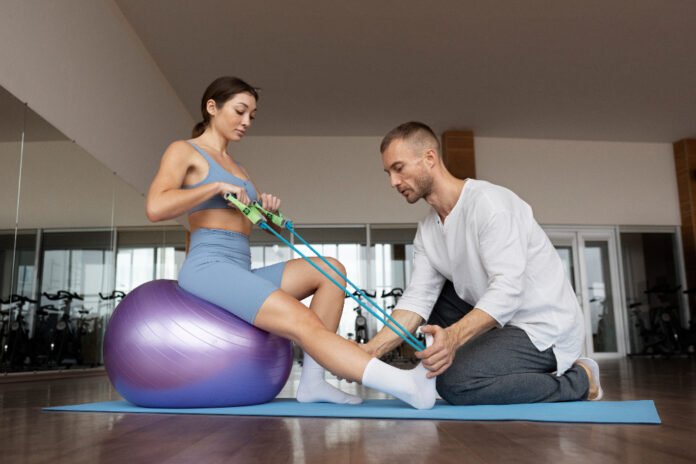Are you an athlete looking to improve your strength and agility, or simply someone eager to stay in peak condition? Do you wonder how sports physiotherapy can help you train smarter and bounce back faster from injuries? If these questions spark your curiosity, you’re in the right place. In this blog post, we’ll explore everything from the role of physiotherapy in sports injury prevention to targeted techniques that can boost athletic performance.
Whether you’re a weekend jogger or a professional competitor, the knowledge you gain here can transform the way you approach physical challenges. We’ll discuss orthopedic rehabilitation, manual therapy methods, and tailored exercise plans designed to suit each individual’s needs. Plus, we’ll touch on how to build a personalised plan with a physiotherapist for athletes in Australia, ensuring local relevance and practical tips for readers Down Under.
Table of Contents
Understanding What Is Sports Physiotherapy?
Sports and exercise physiotherapy focuses on assessing, treating, and preventing injuries that commonly occur during athletic activities. It sometimes involves high-level performance training, but it’s not exclusive to professional athletes. Indeed, physiotherapy for athletes can include everything from recreational runners looking to perfect their stride to seasoned marathoners aiming to shave minutes off their personal bests.
At its core, sports and exercise physiotherapy leans on evidence-based knowledge to develop treatment strategies suited to the specific demands of different sports. These strategies address biomechanics (such as body alignment and posture), muscle function, and joint stability. By focusing on the body as a whole, practitioners can pinpoint areas of weakness or imbalance that might lead to injuries, and then provide targeted solutions.
The Importance Of Physiotherapy In Sports
The importance of physiotherapy in sports can’t be overstated. Athletes often place huge demands on their bodies, which puts them at a higher risk of injuries. By identifying potential imbalances, a qualified sports physiotherapist can put together a proactive plan. This plan might target specific muscle groups or encourage better posture during a workout, decreasing the chance of strains or overuse issues.
One critical factor is early identification of red flags. Through periodic assessments, physiotherapists can spot tight muscles, poor biomechanics, or underlying joint instability. Correcting these issues before they escalate helps athletes maintain consistency in their training routine. Furthermore, preventive strategies often involve strength and conditioning exercises to reinforce tendon and ligament health, thereby reducing the likelihood of acute injuries such as sprains.
Orthopedic Physiotherapy And Rehabilitation
Orthopedic physiotherapy deals with musculoskeletal problems, ranging from minor tendon strains to significant ligament tears. In sports, common issues include knee injuries (ACL tears, meniscus problems), ankle sprains, and shoulder impingements. Each of these conditions can knock an athlete off their game if not managed the right way.
Physiotherapists specialising in orthopedics focus on diagnosing the root cause of these injuries. For instance, a sore knee might stem from weak hips or collapsed arches in the feet. By conducting thorough assessments, they can devise treatment plans that address the immediate pain while also looking at the broader mechanical contributors.
Proven Sports Physiotherapy Techniques
Manual therapy forms a crucial part of many sports physiotherapy techniques. These hands-on methods can include joint mobilisation, soft tissue massage, and muscle stretching. By applying controlled pressure or movement to specific areas, physiotherapists improve blood flow, alleviate muscle tension, and encourage greater range of motion.
What sets manual therapy apart is its immediate effect on pain relief and flexibility. It’s especially beneficial after intense training sessions or when recovering from an acute injury. For instance, if you’ve just completed a marathon, your quads and calves might feel exceptionally tight. A trained physiotherapist can use soft tissue massage to release tension in these areas, helping you bounce back faster.
Creating A Personalised Plan With A Physiotherapist For Athletes
An effective physiotherapy plan starts with a thorough assessment. This initial stage may include biomechanical evaluations, muscle strength tests, and a review of your exercise history. By identifying any asymmetries or weak links, the physiotherapist can make a targeted diagnosis. From there, a personalised road map for recovery and performance enhancement emerges.
Tailored physiotherapy methods often combine manual therapy, exercise prescription, and education on best practices. For instance, you might learn the optimal way to land when jumping or how to pivot on your foot to avoid twisting an ankle. These lessons aren’t just for the short term. They become part of your overall training routine and can reduce the likelihood of future injuries.
Long-Term Strategies For Athletic Performance
Athletic rehabilitation physiotherapy isn’t just about bouncing back from an injury. It’s also a long-term commitment to your body’s health. Preventative maintenance could involve weekly or monthly check-ups with your physiotherapist, even when you’re feeling tip-top. Think of it like a tune-up for your car—spotting small issues early can stop them from escalating later.
Continued rehabilitation might involve refining muscle groups that are prone to weakness or poor activation. For instance, distance runners might devote extra time to their hamstring strength and hip stability, since these areas can influence stride efficiency. Additionally, staying on top of flexibility and mobility ensures you retain full range of motion, making your athletic movements smoother.
Conclusion
Summing up, engaging with a physiotherapist for athletes can transform your entire approach to training, competition, and recovery. Instead of waiting for injuries to pop up, why not invest in a proactive strategy that helps you minimise risks and keep you performing at your peak? From manual therapy to exercise-based physio plans, every technique covered here contributes to a more resilient, better-functioning body.








